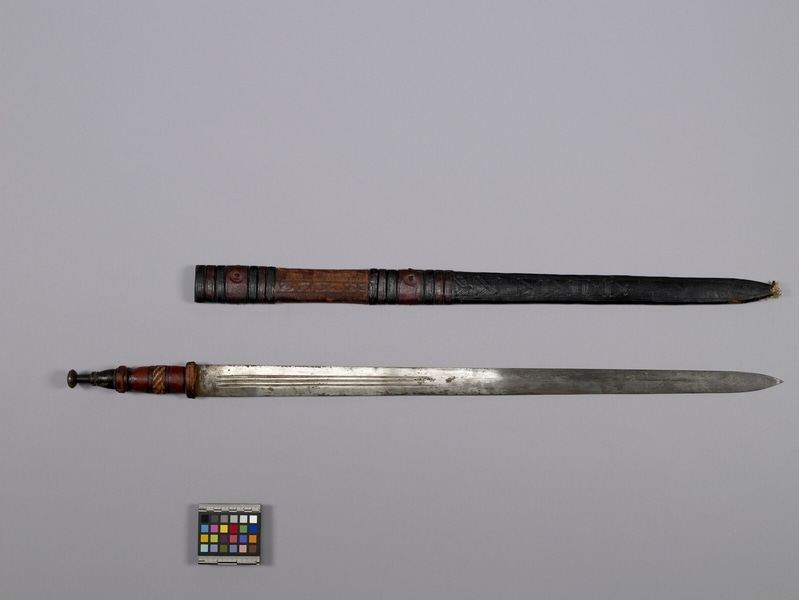Sword Item Number: K2.414 a-b from the MOA: University of British Columbia


Description
Sword (a) with leather scabbard (b). The sword handle is covered in red and black leather with a band of red leather and plant fibre weaving in a diagonal linear design, and a metal finial. The sword blade has three indented lines running lengthwise from near the blade base to nearly halfway down the blade. The scabbard is composed of several bands of alternating red and black leather, a section of mottled red and brown leather stamped with several bands of geometric pattern, another section of alternating red and black bands, and a black laterh tip stamped with linear designs.
History Of Use
This sword (fángo) lacks a cross-guard, which was a common design feature among Mande cultural groups. Long swords like this have been used in the Malinke community since the establishment of the Mali empire. They are used primarily in combat, and are long enough to be effective for both mounted combat or close-range combat on foot. While most swords produced in the Malinke community have curved blades, there is a frequest tradition of repurposing European blades into new swords; likely this is one such blade. The subtle geometric designs on the scabbard (fang-laa) are likely the result of widespread Islamic influence in Sahelian Africa.
Item History
- Made in Sierra Leone ? or Mali ?
- Owned by British Museum before August 1960
- Received from British Museum (Exchanger) during August 1960
What
- Name
- Sword
- Identification Number
- K2.414 a-b
- Type of Item
- sword
- Material
- leather skin, metal, fibre, plant fibre and dye
- Manufacturing Technique
- stamped, woven and hammered
- Overall
- height 95.3 cm, width 5.2 cm, depth 2.9 cm
Who
- Culture
- Malinke
- Previous Owner
- British Museum
- Received from
- British Museum (Exchanger)
Where
- Holding Institution
- MOA: University of British Columbia
- Made in
- Sierra Leone ? or Mali ?
When
- Ownership Date
- before August 1960
- Acquisition Date
- during August 1960
Other
- Item Classes
- metalwork
- Condition
- fair
- Accession Number
- 0022/0039 a-b